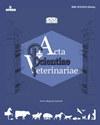Intracranial Meningioma in a Dog - Treatment with Radiotherapy
IF 0.2
4区 农林科学
Q4 VETERINARY SCIENCES
引用次数: 0
Abstract
Background: The most common primary brain neoplasm is meningioma. Dolichocephalic breeds are predisposed and there is no sexual predilection. Clinical signs depend on the location and size of the tumor and have a progressive course. Primary treatement includes surgery, radiotherapy or both. This study aimed to describe the treatment of a dog with suspected intracranial meningioma with definitive radiotherapy, which resulted in significant clinical improvement and prolonged survival. Case: A 9-year-old Shetland Shepherd bitch was diagnosed with a head tilt to the left side that progressed over a few weeks. She previously received corticosteroid therapy, which resulted a clinical improvement that worsened after treatment was discontinued. Computed tomography revealed an extra-axial brain mass in the caudal fossa, lateralized to the right, well-delimited, and measuring approximately 1.5 × 1.4 × 1.7 cm, suggestive of intracranial meningioma. The patient was treated with radiotherapy using Cobalt-60 equipment, with 18 daily fractions of 2.5 Gy at a total dose of 45 Gy using parallel and opposite technique fields. A new tomography performed 30 days after treatment showed a remission of 85% of the initial brain mass measuring approximately 0.9 × 1.0 × 0.5 cm, as well as complete resolution of the clinical signs initially presented. After 14 months, the patient presented with signs of lethargy and ataxia and was medicated with hydroxyurea at a dose of 50 mg/kg 3 times a week and corticosteroid therapy. However, the patient’s neurological condition deteriorated, and she was subjected to reirradiation using the same protocol used previously, which resulted in clinical improvement and a 54% reduction in tumor volume on magnetic resonance. As a late side effect, only permanent alopecia in the irradiated region was observed. The patient died of disease 330 days after the second course of radiotherapy, with a total survival time of 1087 days. Discussion: Meningiomas are extra-axial neoplasms of the central nervous system that grow inside the dura mater. The literature shows that meningiomas are more common in dolichocephalic races with a mean age of 9 years, which supports our findings. Meningiomas most commonly affect the cortical thalamus and cerebellopontine region in dogs, which are normally associated with vestibular symptoms, as seen in this case. Diencephalic damage can result in vestibular signals since the thalamus functions as a relay station for vestibular afferent stimuli that are relayed to the cerebral cortex. In addition to the vestibular syndrome, common clinical signs associated with meningiomas in dogs include seizures, behavioral changes, and walking in circles, which are frequently misinterpreted due to tumor-induced side effects, such as cerebral edema, obstructive hydrocephalus, and cerebral hernia. Advanced imaging techniques should be used to diagnose intracranial neoplasms. In this case, computed tomography was critical for diagnosis and treatment planning. Meningioma treatment may comprise palliative measures, surgery, and radiotherapy. Radiotherapy as a single treatment can improve the quality of life with a decrease in clinical signs and a median survival time of approximately 250-536 days, as reported in the literature. Hydroxyurea can be a therapeutic option in inoperable cases and for patients with clinical limitations to undergo successive anesthesia during radiotherapy. Its most serious side effect is progressive myelosuppression. It can cause temporary partial tumor remission and improvement in clinical signs. As previously stated, radiotherapy can be an effective primary treatment option for treating intracranial meningiomas in dogs, with significant improvement in neurological clinical signs and mild side effects. Keywords: dogs, central nervous system, radiotherapy, reirradiation, oncology. Título: Meningioma intracraniano em cão - tratamento com radioterapia Descritores: cães, sistema nervoso central, radioterapia, reirradiação, oncologia.犬颅内脑膜瘤的放射治疗
背景:脑膜瘤是最常见的原发性脑肿瘤。多头品种易患,没有性偏好。临床症状取决于肿瘤的位置和大小,并有一个渐进的过程。主要治疗包括手术、放射治疗或两者兼而有之。本研究旨在描述对疑似颅内脑膜瘤的狗进行明确放疗的治疗,结果显着改善了临床效果并延长了生存期。案例:一只9岁的设得兰牧羊犬母狗被诊断出头部向左倾斜,这种情况持续了几周。她以前接受过皮质类固醇治疗,导致临床改善,治疗停止后恶化。计算机断层扫描显示尾侧窝脑轴外肿块,向右偏侧,边界清楚,尺寸约为1.5 × 1.4 × 1.7 cm,提示颅内脑膜瘤。患者使用钴-60设备进行放射治疗,每日18次2.5 Gy,总剂量为45 Gy,采用平行和相反的技术场。治疗后30天进行的新断层扫描显示,最初的脑肿块(约0.9 × 1.0 × 0.5 cm)缓解了85%,并且最初出现的临床症状完全消失。14个月后,患者出现嗜睡和共济失调症状,给予羟基脲50 mg/kg剂量,每周3次,同时给予皮质类固醇治疗。然而,患者的神经系统状况恶化,她接受了先前使用的相同方案的再照射,导致临床改善,磁共振显示肿瘤体积缩小54%。作为一个晚期的副作用,只有永久性脱发在照射区域被观察到。患者在第二期放疗后330天因病死亡,总生存时间1087天。讨论:脑膜瘤是生长在硬脑膜内的中枢神经系统轴外肿瘤。文献显示,脑膜瘤在平均年龄为9岁的多头畸形种族中更为常见,这支持了我们的研究结果。脑膜瘤最常影响狗的丘脑皮质区和桥小脑区,通常与前庭症状相关,如本例所示。间脑损伤可导致前庭信号,因为丘脑作为前庭传入刺激的中继站,将前庭传入刺激传递到大脑皮层。除了前庭综合征外,与犬脑膜瘤相关的常见临床症状还包括癫痫发作、行为改变和绕圈行走,这些症状经常被误解为肿瘤引起的副作用,如脑水肿、阻塞性脑积水和脑疝。诊断颅内肿瘤应采用先进的影像学技术。在这种情况下,计算机断层扫描对诊断和治疗计划至关重要。脑膜瘤的治疗可包括姑息措施、手术和放射治疗。据文献报道,放疗作为单一治疗可以改善生活质量,减少临床症状,中位生存时间约为250-536天。羟基脲可作为一种治疗选择,在不能手术的情况下,并为患者的临床限制,在放疗期间进行连续麻醉。其最严重的副作用是进行性骨髓抑制。它可以引起暂时的部分肿瘤缓解和临床症状的改善。如前所述,放射治疗是治疗犬颅内脑膜瘤的一种有效的主要治疗选择,可显著改善神经学临床症状,副作用轻微。关键词:狗,中枢神经系统,放疗,再放疗,肿瘤学。Título:颅内脑膜瘤,脑脊膜瘤,脑脊膜瘤,放射治疗,脑脊膜瘤,脑脊膜瘤,脑脊膜瘤,放射治疗,脑脊膜瘤,放射治疗,脑脊膜瘤,脑脊膜瘤,放射治疗,脑脊膜瘤,脑脊膜瘤,放射治疗,脑脊膜瘤。
本文章由计算机程序翻译,如有差异,请以英文原文为准。
求助全文
约1分钟内获得全文
求助全文
来源期刊

Acta Scientiae Veterinariae
VETERINARY SCIENCES-
CiteScore
0.40
自引率
0.00%
发文量
75
审稿时长
6-12 weeks
期刊介绍:
ASV is concerned with papers dealing with all aspects of disease prevention, clinical and internal medicine, pathology, surgery, epidemiology, immunology, diagnostic and therapeutic procedures, in addition to fundamental research in physiology, biochemistry, immunochemistry, genetics, cell and molecular biology applied to the veterinary field and as an interface with public health.
The submission of a manuscript implies that the same work has not been published and is not under consideration for publication elsewhere. The manuscripts should be first submitted online to the Editor. There are no page charges, only a submission fee.
 求助内容:
求助内容: 应助结果提醒方式:
应助结果提醒方式:


